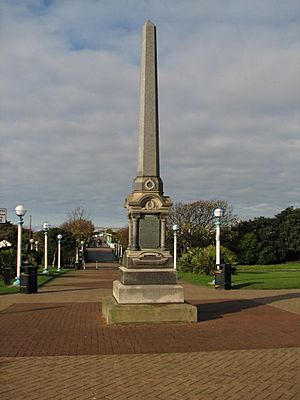Monumental Obelisk, Southport facts for kids
The Monumental Obelisk, Southport is a tall stone monument in Southport, Merseyside, England. It stands on the Promenade, a popular walkway by the sea. This special monument remembers important events, especially the brave work of the Southport lifeboats. It particularly honors the fourteen lifeboatmen who sadly lost their lives when their boat overturned in 1886. A man named Thomas Robinson designed the monument, which is made of granite. It is considered a very important historical building, known as a Grade II listed building.
Contents
A Sad Day and a Special Memorial
On a very stormy day, December 9, 1886, a German ship called the Mexico got stuck on a sandbank near Ainsdale. Three lifeboats rushed out to help. These were the Eliza Fernley from Southport, the Laura Janet from St Annes, and the Charles Biggs from Lytham.
The Lytham lifeboat successfully rescued the crew from the Mexico. But sadly, the other two lifeboats, the Eliza Fernley and Laura Janet, overturned in the rough seas. All thirteen crew members from the St Annes lifeboat were lost. Only two of the sixteen crew members from the Southport lifeboat survived. This was the worst disaster in the history of the Royal National Lifeboat Institution.
After this terrible event, John Unwin, who was the mayor of Southport, started a special fund. This fund raised a lot of money, about £31,000. Most of this money helped the families of the brave men who were lost. Some of the money was also used to build memorials to remember them. In Southport, a memorial was built in the cemetery. Another important memorial, this obelisk, was built on the Promenade.
This obelisk not only remembers the loss of the Eliza Fernley crew. It also celebrates the launch of its replacement lifeboat, the Edith and Anne, in 1888. It also honors the achievements of two earlier lifeboats. Plus, it marks the Golden Jubilee of Queen Victoria in 1887, which was a big celebration for the Queen's 50 years on the throne. The obelisk itself came from Aberdeen and cost £160. Thomas Robinson designed the memorial and also carved it. The total cost was £219. Mayor Unwin officially revealed it on June 28, 1888.
What Does It Look Like?
The monument is made from grey granite, a very strong stone. It stands on three square steps. On top of these steps is a base called a plinth. This plinth has columns at its corners. On each side of the plinth, there is a bronze plaque. Three of these plaques have writing on them, but the south side is blank. On top of the plinth stands the tall, pointed obelisk. Its edges are slightly angled, which is called chamfered.
The plaque on the north side has this inscription:
- THE 'ELIZA FERNLEY',
- PRESENTED BY JOHN FERNLEY,
- Esq. OF BIRKDALE
- 1874, SAVED THE CREWS OF NINE VESSELS
- NUMBERING 53 LIVES
- This lifeboat was capsized
- in a gale, Dec. 9-10 1886
- When Fourteen of her Heroic
- Crew were Drowned. She was Replaced by the 'Mary Anna', 1886.
This tells us that the Eliza Fernley lifeboat was given by John Fernley in 1874. Before the disaster, it saved 53 lives from nine different ships! It also reminds us that 14 brave crew members drowned when it overturned in 1886. The lifeboat was later replaced by one named the Mary Anna.
Why Is It Important?
This memorial was officially recognized as a Grade II listed building on July 29, 1999. A Grade II listing means it is a "building of national importance and special interest." It's the lowest of three grades, but still shows it's a valuable part of history.
Other Lifeboat Memorials
The Lifeboat Memorial in Southport Cemetery is also a Grade II listed building. There are also similar memorials in Lytham and St Annes. The memorial in Lytham is in the churchyard of St Cuthbert's Church. It looks like a tall, pointed tower. The St Annes memorial is on the Promenade there. It features a statue of a lifeboatman looking out to sea.


